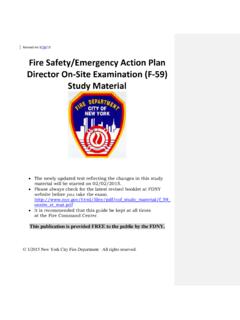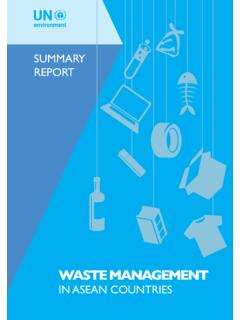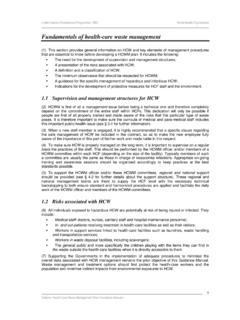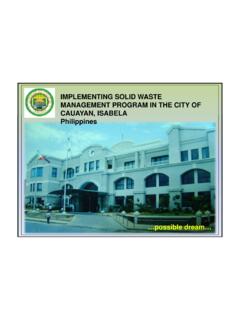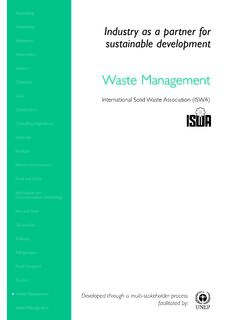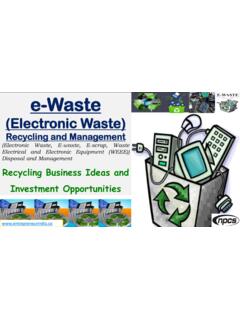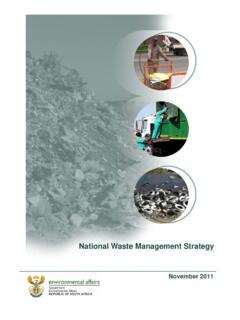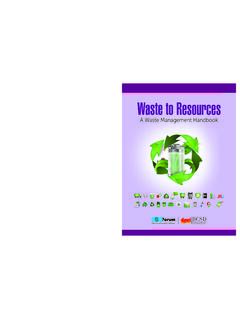Transcription of HAZARDOUS WASTE MANAGEMENT PLAN
1 HAZARDOUS WASTE MANAGEMENT . PLAN. HAZARDOUS WASTE . MANAGEMENT PLAN. (2016). Published by Environmental Health and Safety Department of Public Safety and Risk MANAGEMENT Feb 2016 draft HAZARDOUS WASTE MANAGEMENT . PLAN. Copies of this plan will be made available to all members of the community at the John Jay College of Criminal Justice that may potentially generate or handle HAZARDOUS wastes. Contents I. Purpose II. Responsibilities III. HAZARDOUS WASTE MANAGEMENT IV. Managing Used Oil V. WASTE Minimization VI. Spill Control VII. Standard Operating Procedures VIII. Training IX. Recordkeeping X. Information and Contacts Appendices A. HAZARDOUS WASTE Analysis Plan B. HAZARDOUS WASTE Label C. HAZARDOUS WASTE Satellite Accumulation Area Sign D.
2 Regulated WASTE Awareness Training I. Purpose The purpose of this document is to present procedures to be followed in complying with the Resource Conservation and Recovery Act (RCRA) and New York State Environmental Conservation Law (ECL). Section 27-0900 et seq. and their regulations. This document compiles in one document many of the items necessary to document compliance with RCRA and New York ECL as they apply to HAZARDOUS WASTE . This document is also written to comply with City University of New York's (CUNY). Environmental Health and Safety Policy Manual, specifically the HAZARDOUS WASTE MANAGEMENT Policy and Procedures. John Jay College of Criminal Justice (henceforth referred to as John Jay College) comprises of two fully occupied and two partially occupied buildings.
3 The two fully occupied buildings, Haaren Hall and New Building are located between Tenth and Eleventh Avenues and 58th and 59th Streets in Manhattan, New York. HAZARDOUS wastes are generated both from academic sources and facility operations. Typical academic sources include chemistry and biology teaching and research laboratories. Additionally, facility operations also generate HAZARDOUS wastes, which can include wastes associated with painting, cleaning, and other maintenance operations and activities. Based on the current rate of generation, John Jay College of Criminal Justice is identified as a Small Quantity Generator of HAZARDOUS wastes. Feb 2016 draft HAZARDOUS WASTE MANAGEMENT . PLAN. The threshold criteria for identifying a generator's HAZARDOUS WASTE category are as follows: Category Generation Quantity Limits Conditionally Exempt Small Quantity Generator 100 kg/mo ( lb/mo).
4 (CESQG). Small Quantity Generator (SQG) 100 kg/mo ( lb/mo) to 1,000 kg/mo (2, lb/mo). > 1,000 kg/mo (>2, lb/mo) or Large Quantity Generator (LQG ) 2 kg acutely HAZARDOUS WASTE Note: These quantities are based on the rate of generation, not the rate of disposal. II. Responsibilities John Jay College of Criminal Justice faculty, staff, students, contractors, and other parties that handle or generate HAZARDOUS wastes are required to properly handle, store and label HAZARDOUS wastes and to comply with applicable federal and state regulations. They are responsible to follow the policies and procedures set forth in this HAZARDOUS WASTE MANAGEMENT Plan. It is the responsibility of all faculty, staff, students, contractors and other parties to see that HAZARDOUS wastes are managed in a safe, healthy, and environmentally sound manner.
5 The John Jay College of Criminal Justice Environmental Health &. Safety Officer (EHS DIRECTOR), and college administration staff are responsible for ensuring that all parties who may or do generate HAZARDOUS WASTE on campus comply with these requirements. Included among the responsibilities of John Jay College's EHS Director is the oversight of HAZARDOUS WASTE MANAGEMENT services at John Jay College. These services include the determination of whether or not a WASTE is a HAZARDOUS WASTE , and WASTE pickup, storage, and shipment. Under federal and state regulations, generators of HAZARDOUS WASTE are accountable for the MANAGEMENT of these wastes from cradle to grave, that is, from their point of generation to ultimate disposal. This responsibility includes taking steps to minimize the amount of WASTE generated, and to minimize the release of HAZARDOUS WASTE (See Appendix A).
6 Civil and criminal penalties may result from failure to comply with these requirements. At John Jay College, generators of HAZARDOUS wastes may be academic facilities such as laboratories, as well as various facility operations. While John Jay College is responsible for maintaining compliance, a student, faculty member, staff person, supervisor, or department head could have individual liability in the event of a violation of environmental requirements. Personnel from federal or state environmental regulatory agencies have the authority to inspect laboratories, storage areas, and other related locations on campus for compliance with applicable regulatory requirements at any time. Within the CUNY and John Jay College system, the following responsibilities are identified.
7 The John Jay College President is responsible for: Feb 2016 draft HAZARDOUS WASTE MANAGEMENT . PLAN. Implementation of the HAZARDOUS WASTE MANAGEMENT Policy and Procedures at John Jay College Communicating the importance of the HAZARDOUS WASTE MANAGEMENT Policy and Procedures throughout the organization. Adherence to the CUNY Compliance Enforcement Policy. The John Jay College Vice President for Finance and Administration is responsible for: Providing adequate human, fiscal, and administrative resources to help assure compliance with HAZARDOUS WASTE regulations and the HAZARDOUS WASTE MANAGEMENT Policy and Procedures. Tracking and reviewing HAZARDOUS WASTE compliance performance. Ensuring that the Dormitory Authority of the State of New York (DASNY) and the EHS DIRECTOR.
8 Interact to support HAZARDOUS WASTE compliance in construction projects. The John Jay College Department Chairs are responsible for: Communicating the importance of the HAZARDOUS WASTE MANAGEMENT Policy and Procedures throughout their respective departments. Assuring that departmental staff and facilities comply with these policies. Notifying the EHS DIRECTOR 30 days prior to the departure of any faculty member. Planning and implementing the removal of WASTE materials from any generator leaving John Jay College for any reason. The John Jay College EHS DIRECTOR is responsible for: Reading and understanding federal, state, and city laws, rules, and regulations relating to HAZARDOUS WASTE and for staying current with changes in the laws, rules, and regulations.
9 Overseeing the development of John Jay College's HAZARDOUS WASTE MANAGEMENT Plan, to achieve the goals of CUNY's HAZARDOUS WASTE MANAGEMENT Policy and Procedures and to address the particular needs of John Jay College with respect to the MANAGEMENT of HAZARDOUS wastes. Interfacing with federal, state and New York City regulatory agencies. Implementing John Jay College's HAZARDOUS WASTE MANAGEMENT Plan. Maintaining required documents and records of HAZARDOUS WASTE training, generation, shipment, and disposal. Directing training of faculty, staff, students and contractors at John Jay College for the performance of their tasks as they may relate to HAZARDOUS wastes in an efficient and competent fashion and the provision of instruction regarding the impact that their activities can have on the environment if performed incorrectly.
10 Feb 2016 draft HAZARDOUS WASTE MANAGEMENT . PLAN. Conducting regular inspections of areas where HAZARDOUS wastes are stored to ensure that HAZARDOUS wastes have been properly identified, labeled, segregated, and stored for collection and disposal and to prevent the accumulation of old, unused, or abandoned chemicals. Awareness of the current legal requirements concerning HAZARDOUS WASTE disposal and to contact the CUNY Office of General Counsel when questions arise. Managing the arrangement of HAZARDOUS WASTE pickups and to ensure that disposal is safely and completely performed. Attending DASNY project meetings to convey requirements related to HAZARDOUS WASTE MANAGEMENT responsibilities at John Jay College, including DASNY's (or DASNY's contractors) training, storage, and disposal manifest responsibilities.

